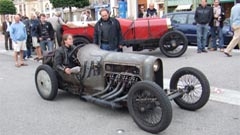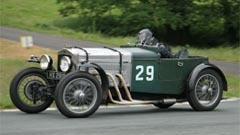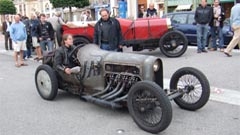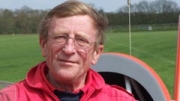
Annie Berrisford is every gentleman’s idea of an English rose.
Petal-complexioned, sparing if not actually eschewing make-up, she lives in a rather rambling and slightly untidy house in middle England backed by a series of solid outbuildings. In higher education she studied art and English history. At first glance a visiting gentleman would probably expect to be overwhelmed by slobbery dogs on arrival and later introduced to a number of horses with names like Leaper and Lightning whose sole aim in life would appear to be defecating on his foot.
The house containing Annie Berrisford is…. not quite like that. As you walk in there are no dogs, slobbery or otherwise, but you do bump into a just-post-War Norton ES2 motorcycle, clearly much-used, occupying quite a lot of space in the hall. In the kitchen there are many pictures of veteran and vintage cars plus an immensely ancient carburettor as a windowsill ornament.
For Annie Berrisford is not the county girl she might seem. By the end of her school days she realised art and history were not in fact quite her demi-tasse, so took up mechanical engineering at the University of Birmingham and gained a Masters Degree in same, along with an award from the Royal Academy of Engineering for her research work.
And this, by a roundabout route, led this particular English rose to being a Design Engineer on BLOODHOUND.
Annie’s passion for cars is…. well, eclectic is the only word. On the one hand is BLOODHOUND, which by any measure is a tad on the extreme side. And on the other, if you are so privileged as to be taken around the outbuildings, you will find not horses but Frazer Nash’s. Old, old Frazer Nash’s, with their archaic chain transmissions. Annie’s personal Frazer is a 1930 Boulogne model roughly three times older than she is. Not the prettiest car Frazer Nash ever built, but one which was owned by Annie’s family decades before she was born; which she drove in VSCC races from the age of 17, and which was finally presented to her by her father – a noted car restorer – as her 21st birthday present.
 Annie racing her 1930 Frazer Nash
Annie racing her 1930 Frazer Nash
Her fiancé Richard also professionally restores cars – seriously historic cars. So the workshops are crammed with the first-ever Bentley, an historic Bugatti, and other similar treasures in various stages of resuscitation. Their ‘family’ car is a wooden-chassied 1914 FN into which Richard has shoe-horned, of all things, a 1908 V8 JAP prototype aero-engine. This is a truly Machiavellian contrivance with – unbelievably – an exposed camshaft between the vee which you sort of chuck oil at from time to time. All sensible mortals would measure this engine’s life in minutes. Annie and Richard race it and also drive it off on holiday to France, which maybe explains Annie’s indifference to make-up, there being little point in applying Channel No 5 when you are about to be sprayed with a not-so-fine mist of Eau de Castrol for a week.
 Annie in the unique JAP engined 1914 FN
Annie in the unique JAP engined 1914 FN
Annie’s involvement in speed record cars came about through earth-moving machinery, which must be a lesson to us all although offhand I cannot quite think what. Whilst at university she opted for the Year Out In Industry programme and joined JCB. The following year JCB rang up and said “D’you want a place on the Dieselmax team” – the voluminous crew they had put together to produce a car capable of taking the Diesel Land Speed Record. JCB are renowned as a DMA (Don’t Mess About) company and had brought in the redoubtable John Piper as Chief Designer, along with the formidable Thrust SSC trio of Richard Noble (Project Consultant), Ron Ayers (Aerodynamicist), and Andy Green (Driver). Which kind of proved they were not messing about. Annie gave the matter mature consideration for a period of time – about 2.8 seconds – and said “You betcha!” Thus she became part of the team who hoisted the Diesel Land Speed Record to 350 mph in August 2006.
A few months later the phone rang again. This time it was John Piper. He said “We’re working on this new and secret project called BLOODHOUND to get to 1,000 mph…..”
This time the answer came back in maybe 1.4 seconds. “Yes….!”
Annie Berrisford has not looked back since, largely because she has not had time. Not a girl normally given to natty headgear – except perhaps a crash helmet – she nonetheless wears a combination of hats on the BLOODHOUND project. The first is planning the ‘operational sequence of engineering events’ – which means she is a sort of diplomatic attaché shuttling between the various engineering kingdoms, all of whom may sometimes become a tiny touch territorial. For a minor example jet engine start-up will require a certain series of actions – but at much the same time the piston engine powering the rocket fuel pump must also be fired up, the Falcon rocket purged and cleared to its ‘pre-enabled’ condition, the run-track over-flown in case a couple of aardvarks have suddenly decided to wander onto the painted line and there start a family…. you name it. The team has to get all these actions into the most sensible order possible, and author a checklist – no, a series of checklists – dictating same. Enter Annie Berrisford, with lists which at this stage are of course a constantly shifting sand…..
Then there is the Risk Mitigation hat, or HRI – Hazard Risk Index.
Maybe a decade ago the British Civil Aviation Authority introduced a Risk Assessment section into the form you have to fill in if you wish to perform a flying display. Basically this section requires you to (a) identify the risk and give it a severity score of 1 to 5; (b) similarly score the likelihood of it actually happening; and (c) to explain what you are doing to mitigate the risk. This occasioned much mirth in the flying display community, and I instructed my company to give a standard answer. The risk? A crash. The likelihood? Well, we haven’t crashed yet in more than 2,000 displays. The risk mitigation? If we do crash we’ll crash in the right place – i.e. not into the crowd. This nonsense placated the CAA – who in any case knew and continue to know what and who are the real risks without such rubbish – and we all sniggered when we bothered to think about it at all.
Not so in BLOODHOUND.
The mental leap is to separate BLOODHOUND from all previous record cars except perhaps Thrust SSC. BLOODHOUND is yes of course a car – but in technology it lies somewhere between a jet fighter, a spaceship, and a ridiculously high-speed railway engine running on solid wheels. Things can, and with the best preparation in the world probably will, go wrong.
And if – when – such a mischance occurs, the last thing you need is to get all in a doo-daa. You do not want to be thinking on your feet any more than you absolutely have to.
Enter Annie with her Hazard Risk Index.
A Level One snag – say, a jet-fuel filter blockage indicator – and the whole device goes back to the hangar, no bloody argument. A Level Two snag – do this and this to try and find the answer, and if that doesn’t work, back to the hangar again.
Quite clearly, this process produces checklists like a government produces Quango’s, although hopefully with a bit more sense. You have a checklist for pre-push-out inspection, another for start-up, another for after-start, another for run-preparation, another for shut-down…..
In the relatively simple aircraft I flew for forty years such checklists became not so much memorised as imprinted on the swede like a tattoo, and you could sort of let your subconscious brain trundle through the rote and rely on it to give you an elbow in the ribs if it found anything amiss.
BLOODHOUND is not like that. With the exception of weapons systems – unless there’s something they haven’t told me about – this is most certainly going to be the most complex surface vehicle on the planet. Checklists are essential.
Annie’s job – this English rose’s job – is to write these checklists.
Including the one for the turn-around between record runs. Which is not – repeat NOT – going to be simple.
The kicker is the FIA rule which ordains that a Land Speed Record shall be the average speed of two runs through the timing trap, one in each direction, to be carried out within one hour.
Back in the old days this was no big deal. You simply slowed down at the end of the first run, turned round 180 degrees, stopped for a gasper and a quick look round the tyres and the rest of the device so see if anything was obviously about to fall off or fly apart, and perhaps had someone pour another can of petrol into it. Then you trod your cigarette into the sand, pulled your goggles down, and blasted off back the way you came.
BLOODHOUND is a touch more complicated. In fact it’s more like turning round a small spaceship. Inside one hour.
The turn-around actually begins as Andy Green starts the run, with the car’s monitoring systems transmitting an ongoing data download which is watched on screens with teeth-clenched concentration both at base and at the turn-around point. The turn-around crew’s interest peaks as Andy exits the timing trap, chops the power, and starts decelerating. If a Level One snag had developed before that the run would have been aborted anyway – but if any red or yellow captions come up during deceleration then various people will have to do some very fast thinking indeed. Or, more accurately, some very fast referring to the Hazard Risk Index.
Perversely, from my own experience of high-performance machinery I suspect that a red (Level One) alert will in a way be less bowel-clenching to the turn-around team than a yellow. If you’ve got a red light then that’s it, the car’s not going anywhere. (Well, except of course where it’s already going right now, and attempting to stop so doing. So if the red’s anything to do with airbrake, parachutes, wheel brakes etc then that will definitely be grabbing your attention).
But if you’ve got a yellow warning that’s different. Yellow means investigate the cause when the car comes to a stop. And investigate it very, very quickly.
Then there’s the minor issue of where to stop the car. Do you just – well, stop it, the way it’s pointing? Or do you drive it relatively slowly round a tear-drop pattern so it ends up pointing back the way it came? At first glance the latter would seem the obvious answer, because there is not much point in re-arming the whole shebang and then firing it off in completely the wrong direction. But the dilemma comes when you realise that one of the first items on the checklist is to attach a mobile crane to BLOODHOUND and hoist it several feet off the deck, primarily to check that the wheels are still in one piece, this not being practical on the ground because only the tiniest possible portion of wheel peeks out of the bottom of the under-body pan at the front or the fairings at the back.
I’ll re-phrase that ‘wheels in one piece’ remark. You know they’re in one piece now – and in any event there are on-board sensors keeping an eye on them – but wheels being ever-so-slightly important, the theory is that it might be kinda nice to take a belt-and-braces approach. For this you do not bring an old British Rail wheel-tapper out of retirement to hit the wheels with a sledge-hammer and listen to the riiiing to tell him it’s sound or the thack to tell him it’s cracked. BLOODHOUND technology, rightly or wrongly, rather recoils from the notion of some old geezer in a boiler-suit whacking the wheels with a sledge-hammer. So what you need is a visual inspection and an electronic eddy-current check for any cracking – and for that you need the car hoisted up.
And while it’s hoisted up, you can of course turn it through 180 degrees simply by walking it round, given you have a crane with a long enough jib.
Easiest and quickest way, says Annie.
Andy Green isn’t so sure. The option is that he should drive the car round the teardrop – it’ll have a turning circle of about 250 metres – align it on the next track about 15 metres to the side of the previous one, and then shut down. If you try to chuck BLOODHOUND around the corner like a Formula One racer it’s going to fall over, cornering not being what it was designed to do, so this could take maybe a minute to a minute-and-a-half. But Andy argues that you’re probably going to lose that time anyway because the EJ200 jet probably needs to idle for that sort of period to stabilise its internal temperatures before shutdown.
Probably…..
Well, the fact is that at this stage of the proceedings nobody really knows. All high-performance jet designers know that if you shut down a jet immediately after a full-power run the internal temperature differentials will cause axial distortion – a posh way of saying that the rotor shaft will bend slightly. Not too big a problem if you give the device time to cool down, because as it does so the shaft obligingly un-bends.
A big problem for BLOODHOUND.
Because no other end-user has ever had a requirement to rapidly shut down a very hot EJ200 and then wish to re-start it again within a short time-frame. Uneven cooling may cause the engine’s own computer to fold its arms and say, “Nah – the shaft’s bent out of limits, mate. Stuff you – I’m aborting the start-sequence as of now”.
The answer? Well, the BLOODHOUND team is looking at it, and no-one knows for sure as yet. They will know a lot more by the time it comes to running, but in the meantime the English rose has to take the certain-safe option and put down on the checklist “Idle the engine over by the air-start cart to even-up cooling – period unknown”.
Well, that’s the easy bit dealt with.
You now have 46 minutes left.
It says here, on this early-version checklist.
With the car back on the deck, the whole team can swarm round it doing numerous jobs simultaneously…. or they can so long as they practise assiduously and follow Annie’s carefully drawn-up sequence. Otherwise they will step on each other’s feet and get in each other’s way.
There is much to be done. The spent rocket must be drawn out backwards onto a cradle – a task not made any easier by the fact that it might be a trifle warm-ish – and a fresh rocket inserted. Sounds simple, but isn’t. At the same time the braking parachutes must be disconnected and fresh ones installed and armed; various body panels have to come off for access; the jet engine has to be re-fuelled; the de-ionised water tank must be topped up; two nitrogen pressure-tanks have to be re-charged; the ice tanks for the APU's cooling system must be replenished; the driver’s oxygen system checked; the cockpit cooling system activated; the jet idled over again on the air-start….. the list goes on. And all without spilling a single drop of any substance – not even an ice cube – onto the desert floor. (A somewhat Draconian self-imposed environmental edict which I kind of suspect might be somewhat bent the first time any member of the crew finds a need to pee at an inconvenient moment).
Done all that? And solved any Level Two (yellow) problems? Great.
You have – it says here on this early-version checklist – 34 minutes left. 34 minutes before Andy must again pass through the timing-gate at Mach 1.4.
The microlight takes off for another check of the run-course in case the aardvarks have come back.
And most of the intrepid turn-around crew hightail it to a safe distance and stuff their fingers in their ears while three people in the equivalent of NBCW (nuclear, biological and chemical warfare) suits do the nasty bit – re-fuelling the rocket tank with High Test Peroxide.
The chemical formula for HTP is H202, which basically means super-duper oxygenated water, which sounds fairly innocuous when you say it quickly. But innocuous HTP certainly ain’t. Contaminate it with practically anything and it will chemically react into super-heated and highly oxygenated steam. Depending on the amount and type of contamination this reaction can be fast or slow. Drip a few drops on the desert and you get a sort of fizz and a few seconds of boiling mud and that’s it. Allow it to contact a liquid like jet fuel and fragments of BLOODHOUND – and the re-fuelers – might be found a mile away after the explosion. It is not ridiculously dangerous if handled properly, but nonetheless two people will do the re-fuel while the third stands by with a high-pressure water cannon to dilute any spillage instanter.
You now have 24 minutes.
Andy gets back in the car, straps in, his oxygen is turned on, and the panels are secured. The APU is fired up, followed by blowing the jet around twice and then starting it up. The air-start cart and everything else is moved away. The rocket is purged by de-ionised water and pre-enabled. The HTP tank is pressurised. The litany of systems checks goes on.
You now have 16 minutes left.
Except that you probably haven’t.
Annie, the English rose who is nursemaid to BLOODHOUND, knows perfectly well that this is an early-version turn-around scenario. The God of Hope would say it is complete. The God of Experience raises a cynical eyebrow and says “Oh no, lass – we can find a lot more complication yet…..”
The God of Experience is probably right – that theoretical 16 minutes will probably dwindle like sand running out of a clasped hand as planning continues.
Nothing is unsolvable. But Annie, the English rose, is going to be busy…..


